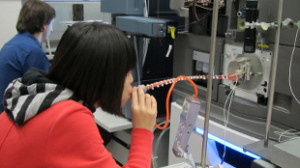Pathologists may be interested to learn that everyone’s breath reveals a signature composition of metabolites that may reflect a lifetime of diet, state of health, illnesses, and exposure to chemicals
New research shows that a person’s “breathprint” is as unique as a fingerprint and may be as effective as bodily fluids in diagnosing diseases. That same research effort is showing that it is feasible to combine breath specimens and mass spectrometry to accurately identify disease. That could give clinical laboratories a new methodology to use when creating diagnostic assays.
These findings are part of a new study conducted by researchers at the Swiss Federal Institute of Technology (ETH Zurich) in Zurich. The study was published by the journal PLOS ONE.
Chemical Compounds in Breath Reveal Lifestyle and Environmental Health
The research team was led by Dr. Renato Zenobi, Professor of Analytical Chemistry at ETH Zurich’s Organic Chemistry Laboratory. He and his team or researchers determined that each individual has a signature composition of metabolites—or compounds produced by chemical reactions in the body—that is exhaled in their breath, noted an article published by TheScientist.com.

Dr. Renato Zenobi (pictured) is a Professor of Analytical Chemistry at the Swiss Federal Institute of Technology. He led a study that revealed that a person’s breathprint is not only unique, it can be analyzed using mass spectrometry to determine an individual’s health status. (Photo copyright Swiss Federal Institute of Technology.)
Enabled by high-resolution, mass spectrometry analytical technology, this breathprint could help practitioners diagnose diseases on the spot. It is a methodology that may one day replace blood and urine tests in medical laboratories, thus eliminating the need to draw a patient’s blood, noted an article published in Medical News Today (MNT).
While the scientists did not investigate the biological reasons for a unique breathprint, they speculate that diet, state of health, illnesses, and exposure to chemicals all may play a role in the composition of individual’s exhaled metabolites.
Researchers Discover Stable, ‘Core Breathprint’ Specific to Each Individual
The study analyzed the exhaled breath of 11 volunteers. Each volunteer blew into a mass spectrometer at different times of the day, over an 11-day period. The researchers found many variations in the chemical composition of exhaled breath of each individual at various times of the day.
However, within that variable pattern, they discovered a stable “core breathprint” that was very specific to each person, reported MNT. “We did find some small variations during the day, but overall the individual pattern stays sufficiently constant to be useful for medical purposes,” observed Pablo Martinez-Lozano Sinues, a Senior Scientist on Zenobi’s team.

A volunteer blows into a mass spectrometer. This allowed researchers to analyze her unique breathprint to determine her health status. (Photo copyright TheScientist.com.)
By using mass spectrometry technology, the scientists were able to identify about 100 different compounds. One compound that was identified was acetone, a product of sugar metabolism that also is found in blood and urine specimens.
Old Chinese Diagnostic Practice Applied to Modern Medicine
Previous studies have suggested the presence of infection and even cancer might be detected by breath. What has been unclear is whether the metabolic contents of breath varied enough from person to person or the breathprint remained stable enough over time to use as a diagnostic tool, noted TheScientist.com report.
The MNT article also pointed out that traditional Chinese doctors have used the smell of a person’s breath for centuries to diagnose diseases. There is also evidence that trained dogs and rats can distinguish between different forms of cancer by smelling the patient.
Breathprint Research Now Being Applied to Diagnosing Lung Diseases
The current goals of the ETH Zurich research study are to further refine this technique for use as a tool for personal breathprints and to recognize characteristic patterns of disease, noted the MNT article. Researchers cited the advantages to using breathprints vs. bodily fluids as a diagnostic tool. Unlike urine and blood tests, the test is noninvasive and the results are instantaneous.
Sinues said that the research group is now working with scientists at the Division of Pulmonary of the University Hospital Zurick to study the potential use of breathprints for diagnosing lung diseases.
“Our goal is to develop breath analysis to the point where it becomes competitive with the established analysis of blood and urine,” Malcolm Kohler, M.D., a professor at the University Hospital Zurich and Pulmonologist, said. He coauthored the ETH Zurick article. “Small, portable mass spectrometers already exist; if their performance can be improved, they will eventually find their way into clinics and doctor’s offices,” added Kohler.
Other Research Focused on Breath Diagnostics
U.S. researchers are also studying the diagnostic potential for breath tests. A study by researchers at Cedars Sinai Medical Center in Los Angeles, which was published in the March 28, 2013, issue of the Journal of Clinical Endocrinology & Metabolism, suggests that a breath test may reveal gut bacteria linked to obesity, noted another MNT article. People with high levels of both hydrogen and methane in their breath are more likely to have a higher body mass index (BMI) and a higher proportion of body fat. This information may be useful in identifying individuals at high risk for obesity and related diseases.
Additionally, an Italian study by researchers at University of Naples tested the potential of using mass spectrometry analysis of the breathprint in diagnosis of liver cirrhosis and the assessment of disease severity. This study was also published in the April 3, 2013 issue of PLOS One. Researchers observed that this diagnostic technique proved to be an effective, noninvasive test that provides immediate results and could be especially useful in patients who are unable to perform blood sampling.
Potential to Combine Breath Specimens and Mass Spec in Clinical Labs
Mass spec technology is being used more and more by medical laboratory scientists to provide quicker, more accurate and less expensive diagnoses than traditional clinical laboratory test procedures. The combination of a different specimen type, like the breathprint, with this technology, may have the potential as a viable clinical diagnostic approach.
—By Patricia Kirk
Related Information:
“Breathprints” Could Diagnose Disease
Chemical Signature Of Exhaled Breath Unique To Each Person



